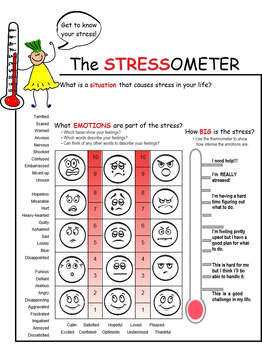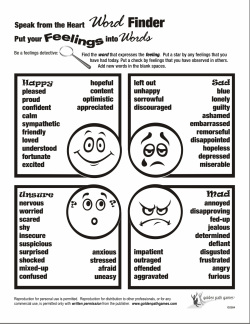Each edition of our quarterly newsletter features a new free therapy resource. Some our our recently featured resources are provided below.
Be a Mastermind: A CBT activity to promote calm thinking, cognitive flexibility and mastery of emotions.
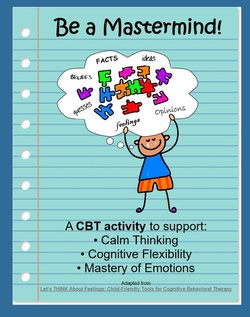
Be a Mastermind: A CBT activity to promote calm thinking
Rationale:
An important component of CBT is learning
1) to distinguish between facts and perceptions (beliefs, opinions, guesses, etc.)
2) to then evaluate those beliefs, opinions and guesses: which are helpful and which are not so helpful?
This activity sets the groundwork for developing cognitive flexibility: the ability to "master your mind" and choose the best, most helpful ways of thinking.
Application:: This resource is intended for psychotherapists who already practice cognitive behavioral therapy with children. Its purpose is to provide visual tools to make the concepts of CBT more accessible for children. It contains an in-session activity as well as a take-home component.
Goals: With this activity, the child:
* identifies a stressful or challenging situation
* identifies the emotions experienced
* describes the facts of what happened
* identifies subsequent thoughts/perceptions (opinions, beliefs, guesses, etc.)
* evaluates the thoughts: are they helpful or not?
View and print Be a Mastermind: A CBT activity
An important component of CBT is learning
1) to distinguish between facts and perceptions (beliefs, opinions, guesses, etc.)
2) to then evaluate those beliefs, opinions and guesses: which are helpful and which are not so helpful?
This activity sets the groundwork for developing cognitive flexibility: the ability to "master your mind" and choose the best, most helpful ways of thinking.
Application:: This resource is intended for psychotherapists who already practice cognitive behavioral therapy with children. Its purpose is to provide visual tools to make the concepts of CBT more accessible for children. It contains an in-session activity as well as a take-home component.
Goals: With this activity, the child:
* identifies a stressful or challenging situation
* identifies the emotions experienced
* describes the facts of what happened
* identifies subsequent thoughts/perceptions (opinions, beliefs, guesses, etc.)
* evaluates the thoughts: are they helpful or not?
View and print Be a Mastermind: A CBT activity
Dealing with Feelings: An introduction to CBT
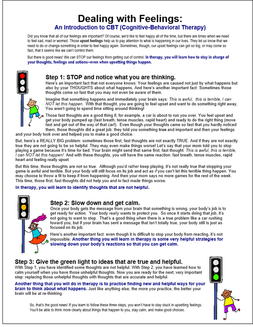
Rationale: In CBT, clients are active partners in creating and carrying out a treatment plan. In order to be an informed partner, they first need to understand what cognitive behavioral therapy is all about. This fact sheet presents an overview of CBT in child-friendly terms.
Click here to view and print.
Goals:
With this activity, children:
- learn about the connection between thoughts, emotions and behavior.
- are informed that, in therapy, they will learn to identify unhelpful thoughts.
- learn about the importance of self-calming in CBT.
- are informed that, in therapy, they will learn to calm their body's automatic reactions to stress.
- are introduced to the concept of cognitive flexibility.
- are informed that, in therapy, they will practice replacing unhelpful thoughts with thoughts that are accurate and helpful.
Rationale: In CBT, clients are active partners in creating and carrying out a treatment plan. In order to be an informed partner, they first need to understand what cognitive behavioral therapy is all about. This fact sheet presents an overview of CBT in child-friendly terms.
Click here to view and print.
Goals:
With this activity, children:
- learn about the connection between thoughts, emotions and behavior.
- are informed that, in therapy, they will learn to identify unhelpful thoughts.
- learn about the importance of self-calming in CBT.
- are informed that, in therapy, they will learn to calm their body's automatic reactions to stress.
- are introduced to the concept of cognitive flexibility.
- are informed that, in therapy, they will practice replacing unhelpful thoughts with thoughts that are accurate and helpful.
Template to make your own cards for
the Mixed Emotions game
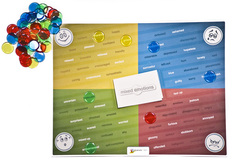
If you have purchased Mixed Emotions, you can add cards to the game by creating your own. Click on a link below to view and print template:
Option 1: template with lines
Option 2: template without lines
For best results when you print, select Scaling: None on your printer's dialog box
The Power of Play
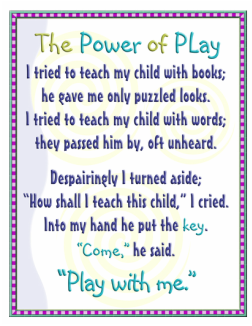
Click on image to view and print.
In celebration of the playful days of summer, here's a poem for you to print and enjoy.
We first saw this poem (author unknown) as a colorful 16x20 poster at the Louisiana Children's Museum in New Orleans. (You can purchase it in their gift shop for $7 if you happen to be in New Orleans. Unfortunately, they don't sell it online.) But we've created our own version for you to print out as a reminder to play plenty this summer!
SPRING 2015: Tumble Tower therapy game
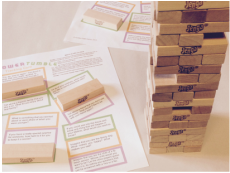
by Marcie Fields Yeager, LCSW, RPT-S
Rationale: Groups, especially in their initial stages, can benefit from activities that build group cohesion and provide an opportunity for players to get to know each other in a safe, non-threatening way. This activity is based on the always-popular tower building game (Jenga™ and its variations). This classic game has often been adapted for the purpose of stimulating conversations. This adaptation creates a game that, while still fun, is played in a way that is also cooperative and therapeutic.
Goals:
1) To build a sense of group unity by playing a game that is both fun and cooperative.
2) To foster communication skills and social interaction by providing a structured, friendly format for sharing personal information.
Application: This version of the game was developed for therapy groups and can accommodate up to four players (possibly more, see instructions). Although specially designed for groups of children, the game can also be played with families or with just one child and the therapist.
Materials needed:
1. One set of Jenga™ (or similar) blocks, one side marked with instructions (see attached)
2. One question/tracking card per player (included, see attached)
View and Print instructions
Rationale: Groups, especially in their initial stages, can benefit from activities that build group cohesion and provide an opportunity for players to get to know each other in a safe, non-threatening way. This activity is based on the always-popular tower building game (Jenga™ and its variations). This classic game has often been adapted for the purpose of stimulating conversations. This adaptation creates a game that, while still fun, is played in a way that is also cooperative and therapeutic.
Goals:
1) To build a sense of group unity by playing a game that is both fun and cooperative.
2) To foster communication skills and social interaction by providing a structured, friendly format for sharing personal information.
Application: This version of the game was developed for therapy groups and can accommodate up to four players (possibly more, see instructions). Although specially designed for groups of children, the game can also be played with families or with just one child and the therapist.
Materials needed:
1. One set of Jenga™ (or similar) blocks, one side marked with instructions (see attached)
2. One question/tracking card per player (included, see attached)
View and Print instructions
WINTER 2015: The “Good Things” Ball Game
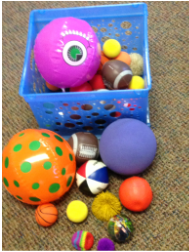
By Daniel Yeager, LCSW, RPT-S
Rationale: Many children come into therapy not knowing what to expect and some may even come to therapy with negative expectations. In the first session with a child, it is important to clearly communicate to the child (and the child’s parents) what therapy is all about.
The “Good Things” Ball Game is one of several activities that I use in the first session to lay the groundwork for therapy. This particular activity demonstrates that:
1) Therapy will take into account a child’s natural need for activity and movement.
2) The child will not be a passive recipient of advice/instruction, but rather an active partner in the therapeutic process.
3) Therapy will engage the “whole child,” using the child’s emotions, interests, assets and strengths to
address the presenting problems.
Goals:
• To relieve anxiety by allowing the child to move around the play room and interact with the therapist in a fun and active manner.
• To demonstrate to the parents the benefit of using playful activities to engage their child in meaningful communication.
• To get a picture of the whole child (not just the problem areas) by giving the child an opportunity to talk about the “good things” in his or her life.
• To help the child form realistic and positive expectations about the therapeutic process.
Materials needed:
1) A large number of soft balls and a container in which to store them. Foam balls and beach balls
make good choices. (Avoid any balls might cause pain or do damage if thrown hard.) In the first part of
this activity, I toss all of the balls to the child, one-by-one but quickly. During the second part of the activity, the child will select one ball at a time to use for a game of catch which ends with a brief description (six total)of some “good things” in the child’s life. When the activity is finished, there will still be lots of balls on the floor, representing many other potential good things that can be discussed in the future.
2) “The Good Things” worksheet
Click here to view and print instructions and worksheet.
Rationale: Many children come into therapy not knowing what to expect and some may even come to therapy with negative expectations. In the first session with a child, it is important to clearly communicate to the child (and the child’s parents) what therapy is all about.
The “Good Things” Ball Game is one of several activities that I use in the first session to lay the groundwork for therapy. This particular activity demonstrates that:
1) Therapy will take into account a child’s natural need for activity and movement.
2) The child will not be a passive recipient of advice/instruction, but rather an active partner in the therapeutic process.
3) Therapy will engage the “whole child,” using the child’s emotions, interests, assets and strengths to
address the presenting problems.
Goals:
• To relieve anxiety by allowing the child to move around the play room and interact with the therapist in a fun and active manner.
• To demonstrate to the parents the benefit of using playful activities to engage their child in meaningful communication.
• To get a picture of the whole child (not just the problem areas) by giving the child an opportunity to talk about the “good things” in his or her life.
• To help the child form realistic and positive expectations about the therapeutic process.
Materials needed:
1) A large number of soft balls and a container in which to store them. Foam balls and beach balls
make good choices. (Avoid any balls might cause pain or do damage if thrown hard.) In the first part of
this activity, I toss all of the balls to the child, one-by-one but quickly. During the second part of the activity, the child will select one ball at a time to use for a game of catch which ends with a brief description (six total)of some “good things” in the child’s life. When the activity is finished, there will still be lots of balls on the floor, representing many other potential good things that can be discussed in the future.
2) “The Good Things” worksheet
Click here to view and print instructions and worksheet.
